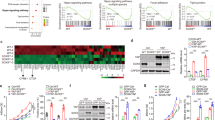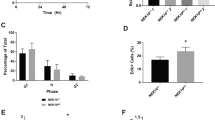Abstract
Nuclear localization and high levels of the Y-box binding protein YB1 appear to be important indicators of drug resistance and tumor prognosis. YB1 also interacts with the p53 tumor suppressor protein. In this paper, we explore a role for p53 in the nuclear localization of YB1. We report that various genotoxic stresses induce nuclear localization of YB1 in a small proportion of treated cells, but only in cells with wild-type p53. We go on to show directly that functional p53 is required for YB1 to translocate to the nucleus. Tumor-associated p53 mutants however are attenuated for YB1 nuclear localization as are mutants mutated in the proline-rich domain of p53. These data link the DNA-damage response of p53 to YB1 nuclear translocation. In addition, we find that YB1 inhibits p53-induced cell death and its ability to trans-activate promoters of genes involved in cell death signaling. Together these data suggest that some forms of p53 cause YB1 to accumulate in the nucleus, which in turn inhibits p53 activity. These results provide a possible explanation for the correlation of nuclear YB1 with drug resistance and poor prognosis in some tumor types, and for the first time implicate p53 in the process of nuclear translocation.
This is a preview of subscription content, access via your institution
Access options
Subscribe to this journal
Receive 50 print issues and online access
$259.00 per year
only $5.18 per issue
Buy this article
- Purchase on Springer Link
- Instant access to full article PDF
Prices may be subject to local taxes which are calculated during checkout









Similar content being viewed by others
References
Appella E and Anderson CW . (2001). Eur. J. Biochem., 268, 2764–2772.
Asakuno K, Kohno K, Uchiumi T, Kubo T, Sato S, Isono M and Kuwano M . (1994). Biochem. Biophys. Res. Commun., 199, 1428–1435.
Baptiste N, Friedlander P, Chen X and Prives C . (2002). Oncogene, 21, 9–21.
Bargou RC, Jurchott K, Wagener C, Bergmann S, Metzner S, Bommert K, Mapara MY, Winzer KJ, Dietel M, Dorken B and Royer HD . (1997). Nat. Med., 3, 447–450.
Bissonnette N, Wasylyk B and Hunting DJ . (1997). Biochem Cell Biol., 75, 351–358.
Braithwaite AW, Sturzbecher HW, Addison C, Palmer C, Rudge K and Jenkins JR . (1987). Nature, 329, 458–460.
Bullock AN, Henckel J, DeDecker BS, Johnson CM, Nikolova PV, Proctor MR, Lane DP and Fersht AR . (1997). Proc. Natl. Acad. Sci. USA, 94, 14338–14342.
Dippold WG, Jay G, DeLeo AB, Khoury G and Old LJ . (1981). Proc. Natl. Acad. Sci. USA, 78, 1695–1699.
Dix BR, O'Carroll SJ, Myers CJ, Edwards SJ and Braithwaite AW . (2000). Cancer Res., 60, 2666–2672.
El-Deiry W, Tokino T, Velculescu V, Levy D, Parsons R, Trent J, Lin D, Mercer E, Kinzler K and Vogelstein B . (1993). Cell, 75, 817–825.
Fortin A, Cregan SP, MacLaurin JG, Kushwaha N, Hickman ES, Thompson CS, Hakim A, Albert PR, Cecconi F, Helin K, Park DS and Slack RS . (2001). J. Cell Biol., 155, 207–216.
Ginsberg D, Mechta F, Yaniv M and Oren M . (1991). Proc. Natl. Acad. Sci. USA, 88, 9979–9983.
Hansen R and Oren M . (1997). Curr. Opin. Genet. Dev., 7, 46–51.
Haupt Y, Maya R, Kazaz A and Oren M . (1997). Nature, 387, 296–299.
Hollstein M, Sidransky D, Vogelstein B and Harris C . (1991). Science, 253, 49–53.
Holm PS, Bergmann S, Jurchott K, Lage H, Brand K, Ladhoff A, Mantwill K, Curiel DT, Dobbelstein M, Dietel M, Gansbacher B and Royer HD . (2002). J. Biol. Chem., 277, 10427–10434.
Jackson P, Ridgway P, Rayner J, Noble J and Braithwaite A . (1994). Biochem. Biophys. Res. Commun., 203, 133–140.
Janz M, Harbeck N, Dettmar P, Berger U, Schmidt A, Jurchott K, Schmitt M and Royer HD . (2002). Int. J. Cancer, 97, 278–282.
Kamura T, Yahata H, Amada S, Ogawa S, Sonoda T, Kobayashi H, Mitsumoto M, Kohno K, Kuwano M and Nakano H . (1999). Cancer, 85, 2450–2454.
Koike K, Uchiumi T, Ohga T, Toh S, Wada M, Kohno K and Kuwano M . (1997). FEBS Lett., 417, 390–394.
Kubbutat MH, Jones SN and Vousden KH . (1997). Nature, 387, 299–303.
Ladomery M and Sommerville J . (1995). Bioessays, 17, 9–11.
Lasham A, Lindridge E, Rudert F, Onrust R and Watson J . (2000). Gene, 252, 1–13.
Li M, Chen D, Shiloh A, Luo J, Nikolaev AY, Qin J and Gu W . (2002). Nature, 416, 648–653.
Littlewood TD, Hancock DC, Danielian PS, Parker MG and Evan GI . (1995). Nucleic Acids Res., 23, 1686–1690.
Mantovani R . (1998). Nucleic Acids Res., 26, 1135–1143.
Matsumoto K and Wolffe AP . (1998). Trends Cell Biol., 8, 318–323.
Mertens PR, Steinmann K, Alfonso-Jaume MA, En-Nia A, Sun Y and Lovett DH . (2002). J. Biol. Chem., 277, 24875–24882.
Momand J, Zambetti G, Olson D, George D and Levine A . (1992). Cell, 69, 1237–1245.
Moroni MC, Hickman ES, Denchi EL, Caprara G, Colli E, Cecconi F, Muller H and Helin K . (2001). Nat. Cell Biol., 3, 552–558.
O'Carroll SJ, Hall AR, Myers CJ, Braithwaite AW and Dix BR . (2000). Biotechniques, 28, 408–410.
Oda K, Arakawa H, Tanaka T, Matsuda K, Tanikawa C, Mori T, Nishimori H, Tamai K, Tokino T, Nakamura Y and Taya Y . (2000a). Cell, 102, 849–862.
Oda E, Ohki R, Murasawa H, Nemoto J, Shibue T, Yamashita T, Tokino T, Taniguchi T and Tanaka N . (2000b). Science, 288, 1053–1058.
Oda Y, Sakamoto A, Shinohara N, Ohga T, Uchiumi T, Kohno K, Tsuneyoshi M, Kuwano M and Iwamoto Y . (1998). Clin. Cancer Res., 4, 2273–2277.
Ohga T, Koike K, Ono M, Makino Y, Itagaki Y, Tanimoto M, Kuwano M and Kohno K . (1996). Cancer Res., 56, 4224–4228.
Ohga T, Uchiumi T, Makino Y, Koike K, Wada M, Kuwano M and Kohno K . (1998). J. Biol. Chem., 273, 5997–6000.
Okamoto T, Izumi H, Imamura T, Takano H, Ise T, Uchiumi T, Kuwano M and Kohno K . (2000). Oncogene, 19, 6194–6202.
Ory K, Legros Y, Auguin C and Soussi T . (1994). EMBO J., 13, 3496–3504.
Prives C and Hall PA . (1999). J. Pathol., 187, 112–126.
Robles AI, Bemmels NA, Foraker AB and Harris CC . (2001). Cancer Res., 61, 6660–6664.
Rogan EM, Bryan TM, Hukku B, Maclean K, Chang AC, Moy EL, Englezou A, Warneford SG, Dalla-Pozza L and Reddel RR . (1995). Mol. Cell Biol., 15, 4745–4753.
Shibahara K, Sugio K, Osaki T, Uchiumi T, Maehara Y, Kohno K, Yasumoto K, Sugimachi K and Kuwano M . (2001). Clin. Cancer Res., 7, 3151–3155.
Shibao K, Takano H, Nakayama Y, Okazaki K, Nagata N, Izumi H, Uchiumi T, Kuwano M, Kohno K and Itoh H . (1999). Int. J. Cancer, 83, 732–737.
Sommerville J . (1999). Bioessays, 21, 319–325.
Stein U, Jurchott K, Walther W, Bergmann S, Schlag PM and Royer HD . (2001). J. Biol. Chem., 21, 21.
Uchiumi T, Kohno K, Tanimura H, Matsuo K, Sato S, Uchida Y and Kuwano M . (1993). Cell Growth Differ., 4, 147–157.
Vater CA, Bartle LM, Dionne CA, Littlewood TD and Goldmacher VS . (1996). Oncogene, 13, 739–748.
Walker KK and Levine AJ . (1996). Proc. Natl. Acad. Sci. USA, 93, 15335–15340.
Wolffe AP . (1994). Bioessays, 16, 245–251.
Yewdell JW, Gannon JV and Lane DP . (1986). J. Virol., 59, 444–452.
Zhu J, Jiang J, Zhou W, Zhu K and Chen X . (1999). Oncogene, 18, 2149–2155.
Acknowledgements
We thank Moshe Oren (Rehovot) and Xin Lu (London) for plasmids. We also thank Kimitoshi Kohno (Kitakyushu) for antibody to YB1, Roger Reddel (Sydney) for IIICF/c cells, Mike Kastan (Johns Hopkins) for RKO cells and Bruce Baguley (Auckland) for amsacrine. This work was supported by grants from the Cancer Society and Health Research Council of New Zealand.
Author information
Authors and Affiliations
Corresponding author
Rights and permissions
About this article
Cite this article
Zhang, Y., Homer, C., Edwards, S. et al. Nuclear localization of Y-box factor YB1 requires wild-type p53. Oncogene 22, 2782–2794 (2003). https://doi.org/10.1038/sj.onc.1206357
Received:
Revised:
Accepted:
Published:
Issue Date:
DOI: https://doi.org/10.1038/sj.onc.1206357
Keywords
This article is cited by
-
PLK1 inhibition promotes apoptosis and DNA damage in glioma stem cells by regulating the nuclear translocation of YBX1
Cell Death Discovery (2023)
-
rSjp40 inhibits activated hepatic stellate cells by promoting nuclear translocation of YB1 and inducing BMP-7/Smad1/5/8 pathway
Parasites & Vectors (2019)
-
MDM2’s social network
Oncogene (2014)
-
Y-Box-binding protein-1 is a promising predictive marker of radioresistance and chemoradioresistance in nasopharyngeal cancer
Modern Pathology (2009)
-
Some p53-binding proteins that can function as arbiters of life and death
Cell Death & Differentiation (2006)



